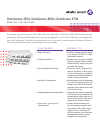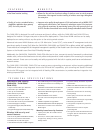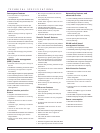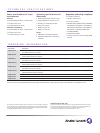
3Alcatel-Lucent OmniAccess 4504,OmniAccess 4604, OmniAccess 4704
T E C H N I C A L S P E C I F I C A T I O N S
Convergence features
• Voice and data on a single SSID for
converged devices
• Flow-based QoS using voice flow classification (VFC)
• Alcatel-Lucent NOE, SIP, Spectralink SVP, SCCP
and Vocera ALGs
• Strict priority queuing for over-the-air QoS
• 802.11e support – WMM, U-APSD and T-SPEC
• QoS policing for preventing network abuse
via 802.11e
• DiffServ marking and 802.1p support for
network QoS
• On-hook and off-hook VoIP client detection
• VoIP call admission control (CAC) using VFC
• Call reservation thresholds for mobile VoIP calls
• Voice-aware RF management for ensuring
voice quality
• Fast roaming support for ensuring mobile
voice quality
• SIP early media and ringing tone generation
(RFC 3960)
• Per-user and per-role rate limits (bandwidth
contracts)
Adaptive radio management
(ARM ) features
• Automatic channel and power settings for
thin APs
• Simultaneous air monitoring and end-user services
• Self-healing coverage-based on dynamic
RF conditions
• Dense deployment options for capacity optimization
• AP load balancing-based on number of users
• AP load balancing-based on bandwidth utilization
• Coverage hole and RF interference detection
• 802.11h support for radar detection and avoidance
• Automated location detection for active RFID tags
• Built-in XML-based Location API for
RFID applications
Wireless intrusion protection
features
• Integration with WLAN infrastructure
• Simultaneous or dedicated air monitoring
capabilities
• Rogue AP detection and built-in location
visualization
• Automatic rogue, interfering and valid AP
classification
• Over-the-air and over-the-wire rogue
AP containment
• Ad hoc WLAN network detection and containment
• Windows client bridging and wireless
bridge detection
• Denial of service attack protection for APs
and stations
• Mis-configured standalone AP detection
and containment
• Third party AP performance monitoring
and troubleshooting
• Flexible attack signature creation for new
WLAN attacks
• EAP handshake and sequence number analysis
• Valid AP impersonation detection
• Frame floods, fake AP and Airjack attack detection
• ASLEAP, death broadcast, null probe
response detection
• Netstumbler-based network probe detection
Stateful firewall features
• Stateful packet inspection tied to user identity
or ports
• Location and time-of-day aware policy definition
• 802.11 station awareness for WLAN firewalling
• Over-the-air policy enforcement and station
blacklisting
• Session mirroring and per-packet logs for
forensic analysis
• Detailed firewall traffic logs for usage auditing
• Application layer gateway (ALG) support for
NOE, SIP, SCCP, RTSP, Vocera, FTP, TFTP, PPTP
• Source and destination Network Address
Translation (NAT)
• Dedicated flow processing hardware for high
performance
• TCP, ICMP denial of service attack detection
and protection
• Policy-based forwarding into GRE tunnels for
guest traffic
• External service interface for third party security
integration for inline anti-virus, anti-spam and
content filtering apps
• Heath checking and load balancing for
external services
VPN server features
• Site-to-site VPN support for branch
office deployments
• Site-to-site interoperability with third party
VPN servers
• VPN server emulation for easy integration
into WLAN
• L2TP/IPSec VPN termination for Windows
VPN clients
• XAUTH/IPSec VPN termination for third
party clients
• PPTP VPN termination for legacy VPN integration
• RADIUS and LDAP server support for
VPN authentication
• PAP, CHAP, MS-CHAP and MS-CHAPv2
authentication
• Hardware encryption for DES, 3DES, AES, MPPE
• Secure point-to-point xSec tunnels for L2 VPNs
Networking features and
advanced services
• L2 and L3 switching over-the-air and over-the-wire
• VLAN pooling for easy, scalable network designs
• VLAN mobility for seamless L2 roaming
• Proxy mobile IP and proxy DHCP for L3 roaming
• Built-in DHCP server and DHCP relay
• VRRP-based N+1 WLAN switch redundancy (L2)
• AP provisioning-based N+1 WLAN
switch redundancy (L3)
• Etherchannel support for link redundancy
• 802.1d Spanning Tree Protocol (STP)
• 802.1Q VLAN tags
WLAN switch-based
management features
• RF Planning and AP Deployment Toolkit
• CentralizedAP provisioning and image management
• Live coverage visualization with RF heat maps
• Detailed statistics visualization for monitoring
• Remote packet capture for RF troubleshooting
• Interoperable with Ethereal and Airopeek analyzers
• Multi-WLAN switch configuration management
• Location visualization and device tracking
• System-wide event collection and reporting
Administration features
• Web-based user interface access over HTTP
and HTTPS
• Quickstart screens for easy WLAN
switch configuration
• CLI access using SSH, Telnet and console port
• Role-based access control for restricted
admin access
• Authenticated access via RADIUS, LDAP or
Internal DB
• SNMPv3 and SNMPv2 support for WLAN
switch monitoring
• Standard MIBs and private enterprise MIBs
• Detailed message logs with syslog event notification
Power consumption
• OAW-4504: 35 W maximum
• OAW-4604: 45 W maximum
• OAW-4704: 60 W maximum






